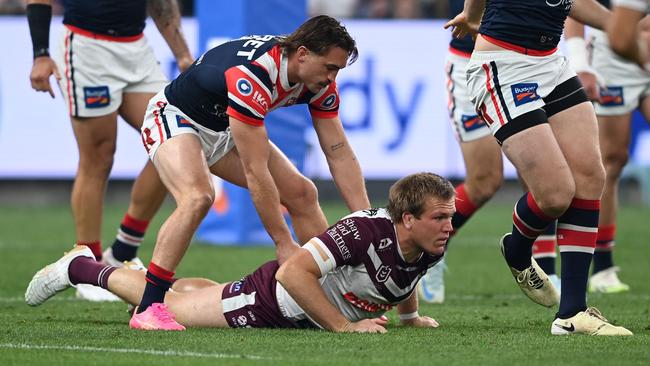Former NRL doc: ‘If Jake wasn’t concussed I’m a monkey’s uncle’
The former chief medical officer of the NRL says Manly should be probed over its handling of Jake Trbojevic’s HIA in the club’s semi-final loss to the Roosters.

The former chief medical officer of the NRL says he was in “no doubt” Jake Trbojevic was concussed in the first 42 seconds of the sudden-death finals clash against the Roosters – and he was horrified the Manly star passed his head injury assessment.
Dr Ron Muratore, chief medical officer of the NRL for six years from 2008 until 2012, has called on the NRL to launch an investigation into Manly’s handling of Trbojevic’s controversial HIA.
“[There was] no way in the world Trbojevic wasn’t concussed,” Muratore said. “When he tried to get up he stumbled. … when he tried to get up he fell down. He didn’t look with it. The Easts players were hanging on to him. If the players were worried about him, why aren’t the doctors?”
Muratore said the NRL should launch an investigation into Manly’s handling of the Trbojevic incident, and if the Sea Eagles were found wanting, they should face significant fines. The NRL’s current chief medical officer Dr Sharron Flahive should look into the incident, he added.

Under the NRL’s concussion protocols, players who exhibit balance disturbance after a hit to the head are banned from taking further part in the game and are banned from the game for 11 days.
“Jake Trbojevic is in all sorts of trouble here,” commentator Warren Smith said on Fox League. “He is rubber legged.”
“This is one of the most incredible openings of a game you have ever seen,” Smith said of the first minute that resulted in Manly’s Tolutau Koula being concussed after a big hit by 116kg Roosters prop Jared Waerea-Hargreaves, to be followed just seconds later by the hit on Trbojevic.
“I can’t see Jake returning, either,” said Fox League commentator Greg Alexander.
Muratore said it is a well established fact concussed players are at higher risk of re-injury and a second concussion. In rare cases, a player who is quickly re-concussed before they can recover are at risk of “second-impact syndrome”, a fatal injury that causes the brain to swell rapidly and catastrophically.
“He shouldn’t even have had an HIA,” Muratore said. “The tests are just tools for the doctors, they do not diagnose concussion.
“The doctor is there to use their clinical judgment … and if he wasn’t concussed I’m a monkey’s uncle.”
Muratore expected there would be more cases like Trbojevic to come in the final two weeks – with higher stakes for the games at the business end of the season.
In a statement to The Australian, the NRL stood by Saturday night’s decision. “In the opinion of the independent doctor in the Bunker, Jake Trbojevic displayed signs which required him to be removed for a Head Injury Assessment,” an NRL spokesman said.
“The doctor performed a Head Injury Assessment on the player as per the normal protocol. The player passed the assessment.”
NRL football boss Graham Annesley said the independent doctor in the NRL Bunker wasn’t satisfied Trbojevic displayed “definitive motor incoordination” and it was “possible motor in co-ordination.”
Annesley said it was possible Trbojevic was unsteady on his feet for no reason.
“Because it’s possible motor incoordination, some people are unsteady on their feet without any reason to be unsteady. In this case, when Jake hit the ground he was starting to get up again and then he was pushed again.
The Bunker doctor said Trbojevic was deemed a category 2, not category 1 that would have immediately banned from the game.
Annesley said the situation “slightly blurred” after the lock forward was pushed back to the ground by Connor Watson as he tried to clear the ruck.
Because of the uncertainty, Trbojevic was deemed a category 2 concussion and reviewed by the club doctor, who cleared him of concussion.
Trbojevic returned to the field after passing the head-injury assessment in the sheds.
The issue of head injury in football and its impacts was again pushed into the spotlight following the revelation Manly NRL rookie Keith Titmuss was suffering Chronic Traumatic Encephalopathy when he died at 20.
He is the youngest Australian sporting player to be diagnosed with the head-knock-related condition.
But while leading sports neuroscientists and doctors such as Muratore are pushing for limiting contact at junior levels, rugby league immortal Wally Lewis, while appealing for better safety for young athletes, doesn’t believe tackling needs to go.
Lewis, who is suffering early on-set dementia believed to be caused by his decorated 14-year footy career, says there is no rugby league if tackling is banned at the junior level, although he is vocal about ridding the game of dangerous plays aimed at the head.
“I understand that [idea] but my point is what happens when you get rid of tackling, there is no game,” Lewis, 64, said on Monday.




To join the conversation, please log in. Don't have an account? Register
Join the conversation, you are commenting as Logout